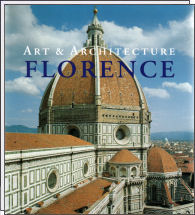EDIZIONE
INGLESE  |
Florence through the Centuries - Notes on the City's History
Myriad myths and legends surround the origins of the city of Florence and the meaning of its name. Unlike the neighboring town of Fiesole, which was established as an Etruscan settlement in the 7th century BC, Florence was not founded until Roman times.
In the year 59 BC, Julius Caesar rewarded the loyal veterans of his army (Lex Julia) with plots of fertile land in the Arno valley. The first settlement was built on a chessboard-like plan in the form of a classical Roman castrum, or army camp, and originally incorporated only a small area extending from today's Via del Cerretani in the north to around the Piazza della Signoria in the south. The original plot distribution can still be traced in the modern cityscape.
The city was dissected by the main streets and trading routes of the Cardo (north–south) and the Decumanus (east–west), which intersected at what is now known as the Piazza della Repubblica.
The development of the Roman colony was facilitated by the convenient location of the site near the famous Via Cassia, the road which linked Rome to the north of Italy. The city had grown considerably by the 3rd century AC and had developed into an important trade center. The first indications of the nascent Christianization by Syrian traders also appear around this time. St. Miniato is reputed, to have t t'& martyred in Florence in the year 250 as part of the persecution of Christians. Construction of the first churches began shortly after this just outside the gates of the city wall. |
EDIZIONE
TEDESCA  |
Florenz im Wandel der Jahrhunderte - Bemerkungen zur Geschichte der Stadt
Urn die Entstehung von Florenz und die ursprüngliche Bedeutung des Stadtnamens ranken sich zahlreiche Mythen und Legenden. Im Gegensatz zum benachbarten Fiesole, das als etruskische Siedlung im 7. Jh. v. Chr. entstand, fällt die Florentinische Stadtgründung erst in römische Zeit.
Im Jahre 59 v. Chr. hatte Julius Caesar den fruchtbaren Boden im Tal des Arno ver-
dienten Veteranen seines Heeres zur Erschließung überlassen (Lex Julia). Nach dem klassischen Typus eines römischen »Castrum« wurde die erste Siedlung über einem schachbrettartigen Grundriß errichtet und umfaßte zunächst nur ein kleines Areal, das von der heutigen Via dei Cerretani im Norden bis ungefähr zur Piazza della Signoria reichte. Deutlich haben sich im Stadtbild bis heute Spuren der damaligen Parzellierung erhalten. Als wichtigste Hauptstraßen und Handelswege durchquerten der Cardo (in nord-südlicher Richtung) und der Decumanus (ost-westlich) die Stadt. Ihren Kreuzungspunkt hatten beide auf Höhe der heutigen Piazza della Repubblica. Die Entwicklung der römischen Kolonie wurde durch die verkehrsgünstige Lage in der Nähe der berühmten Via Cassia, die Rom mit den nördlichen Regionen verband, gefördert. Schon im 3. Jh. n. Chr. war die Stadt beträchtlich gewachsen und zu einem bedeutenden Handelsplatz geworden. Aus jener Zeit stammen zudem die ersten Hinweise auf eine beginnende Christianisierung durch syrische Kaufleute. Im Jahr 250 soll der Hl. Miniato im Zuge der Christenverfolgung in Florenz das Martyrium erlitten haben, schon bald darauf wurde vor den Toren der Stadtmauern mit dem Bau der ersten Kirchen begonnen.
|
 
 

Rolf C. Wirtz - Clemente Manenti
ART & ARCHITECTURE FLORENCE
editore KONEMANN
edizione 2005
pagine 560
formato 14x16
cartonato con sovracoperta colori
tempo medio evasione ordine
2 giorni
15.90 €
9.90 €
ISBN : 3-8331-1481-9
EAN : 9783833114816
|
|